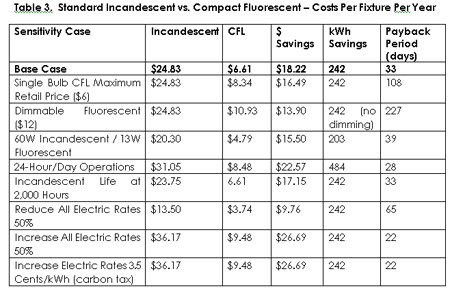|
This two-part article presents a case study of lighting efficiency in a sample of restaurants in Northern Virginia. Part I asks four simple questions about these restaurants:
- Are the area lights (e.g., ceiling lights) incandescent or fluorescent?
- Are the swag lights suspended over the tables (also called task lights) incandescent or fluorescent?
- Are the interior lights dimmed or turned off due to daylight illumination?
- Are the exterior lights off during the day?
In answering these questions, Part I also quantifies the direct economic cost of using one popular form of incandescent bulb compared to a lumen-equivalent compact fluorescent. Part II of this article extends the observations and calculations regarding lighting efficiency, lighting costs, and consumer decision-making to the national level.
Observations
During July, 2007 I visited 50 restaurants in Northern Virginia at
random, consisting of 34 fast-food restaurants, coffee shops, donut
shops, pizza places, ice cream parlors, etc. (collectively fast-food
restaurants) in 15 national chains and 16 casual dining restaurants in
12 regional or national chains to see how they compared on the four
efficiency questions listed above. All of the visits took place in the
middle of the day under full sun. Only interior lights in the dining
area and exterior lights (excluding signs) were considered. Lights on
or above the food-service counter, lighting directed at wall-mounted
menus, and interior accent lights were excluded.
Fast-food Restaurants
Table 1 shows the results for the fast-food restaurants. It shows that
the exterior lighting was off in 33 of the 34 outlets (the exception
being one Starbucks) and 31 of the 34 used only or mostly fluorescent
ceiling lights, including compact fluorescents (CFLs). However, of the
27 restaurants with swag lighting, 18 used only incandescent lights,
mostly standard household bulbs. The table also shows considerable
variation within outlets of the same chain. Of the five chains for
which three or more outlets were reviewed (McDonald’s, Wendy’s,
Subway, Burger King, and Starbucks) none used the same lighting styles
in all outlets. In only one restaurant of the 34 (a McDonald’s) were
any lights purposely turned off or dimmed during the day. Although a
few outlets in a few chains used halogen incandescent bulbs, only one
chain (Starbucks) primarily used halogen rather than standard
household bulbs.
Table 1. Lighting in Northern Virginia Fast-food Restaurants


FT = Fluorescent Tube
CFL = Compact Fluorescent
INC = Incandescent (Standard & Halogen)
Casual Dining Restaurants
The sample of casual dining restaurants consisted of 16 outlets from
12 chains: two outlets each of Panera Bread, Olive Garden, Uno Chicago
Bar & Grill, and Sweetwater Tavern; and one outlet each of
International House of Pancakes, Applebee’s, Romano’s Macaroni Grill,
Friday’s, Red Robin, Red Lobster, Atlanta Bread, and Chevys Fresh Mex.
The sample of casual dining restaurants was smaller than the sample of
fast-food restaurants because the interior lighting in the casual
dining restaurants was much more homogeneous than in the fast-food
restaurants. Almost all the interior lighting was incandescent, with a
much higher percentage of halogen bulbs than in the fast-food
restaurants. Of the twelve chains, only one had even partial
fluorescent usage (swag light CFLs at Sweetwater Tavern) and none
showed any evidence of purposeful interior dimming. Overall, the
larger stand-alone suburban restaurants averaged several hundred
interior bulbs and more than 15-20,000 watts of incandescent lighting.
Apart from the nearly complete rejection of fluorescent lights, some of the more extreme examples of energy inefficiency included:
- A string of about 75 decorative incandescent lights, totaling at least 3,000 watts (with ¼ of the bulbs burned out) illuminating a day-lit outdoor patio devoid of customers (Chevys Fresh Mex).
- A restaurant with exceptionally high ceilings and exceptionally large numbers of ceiling-mounted incandescents, many of which were burned-out and left in place (Panera Bread).
- Swag light fixtures with narrow open-ended shrouds so that maximum incandescent wattage became minimum spot illumination (many restaurants to varying degrees).
- Operating exterior spots in daylight so bright that it was necessary to look directly into the fixture to see if the light was on (Olive Garden).
- Operating exterior swag lights (albeit CFLs) in bright daylight on an outdoor patio (Sweetwater Tavern).
The Cost of Lighting One Bulb
Table 2 calculates the direct cost of a common restaurant lighting
choice: the use of a 75-watt standard incandescent bulb instead of a
lumen-equivalent 19-watt spiral compact fluorescent (CFL) in a
standard screw-in fixture. The CFL is available at Lowe’s or Home
Depot for $2 each in a pack of four. It has an operating life of
10,000 hours and a lighting efficacy exceeding 60 lumens per watt. The
incandescent bulb costs $0.50, has an operating life of 1,000 hours,
and a lighting efficacy of 15 lumens per watt. (Numerous similar bulbs
with similar performance characteristics are available. In general,
there is about a 4:1 capital cost advantage for the standard
incandescent, a 10:1 longevity advantage for the CFL, and a 4:1
efficacy advantage for the CFL. The halogen / CFL relationship is
different, as discussed later.) The cost calculations on Table 2 use
the Dominion Power rate schedule that would apply to a typical
mid-sized restaurant in Virginia (commercial GS-2, demand billing).

The table shows that standard incandescent usage costs about $25 per fixture per year versus $7 for the CFL, for a difference of about $18 per fixture per year. The incandescent uses 242 kWh per fixture per year more than the CFL. For a fast-food restaurant with fluorescent ceiling lights and 15 incandescent swag lights the difference is more than $300 and 3,500 kWh per year. For the casual dining restaurants the difference can easily exceed thousands of dollars and 50,000 kWh per year.
This $18 per fixture per year advantage for the CFL actually understates its economic value. It excludes the cost of the incremental cooling required to remove the higher incandescent heat (net of winter heating benefits), the incremental inventory costs for the larger required stock of incandescent bulbs, and the much larger maintenance cost to deal with the 10x more frequent replacement rate.
For a halogen bulb with the same wattage and lighting efficacy as the standard incandescent but an initial cost of $3.00 and a 3,000 hour operating life, the net savings for the CFL is about $20 per fixture per year and the payback is instantaneous. In this case, the CFL has an operating lifetime advantage of 3.3x (rather than 10x versus the standard incandescent), a lumen efficacy of 4x, and a capital cost advantage of 1.5x. Excluding the cost of new fixtures for a retrofit application (since many halogen bulbs have halogen-specific and bulb-specific fixtures) the CFL pays for itself immediately. These results are robust for normal variations in pricing, efficacy, and operating lifetimes.
Sensitivities
Table 3 shows some sensitivity cases for the CFL / standard
incandescent case. A CFL / halogen case would yield similar results.
The key observation is that the payback period for the higher initial
cost CFL is not measured in years but in days. In the base case, the
higher cost of the CFL is recouped in 33 days, at a net savings of $18
per fixture per year. For a 60-watt incandescent, which is also common
in fast-food restaurants (as is a similar halogen bulb in casual
dining restaurants), the lumen-equivalent 13-watt CFL pays for itself
in 39 days, with a net savings of $16 per fixture per year. In the
base case 75-watt / 19-watt comparison even if the CFL is bought at
the maximum possible retail price of $6 per bulb, as would be the case
at a grocery store, the payback is still only 108 days. For a dimmable
fluorescent costing $12 per bulb, the payback is 227 days, or less
than eight months. If electric rates are cut in half, reflecting the
lowest cost regions of the country, the payback is 65 days. If rates
are increased 50%, representing the higher cost regions of the country
or a 3.5 cents/kWh tax is added (e.g., a carbon tax) the payback
declines to 22 days.

The conclusion is that to the extent the quality of illumination among the various types of bulbs is roughly equivalent, incandescent usage is extremely energy- and economically-inefficient. Given that this usage is occurring in profit-making commercial enterprises rather than, for example, ordinary residential households, the decisions appear to be irrational.
![]()
Copyright © 2002-2006, CyberTech, Inc. - All rights reserved.
